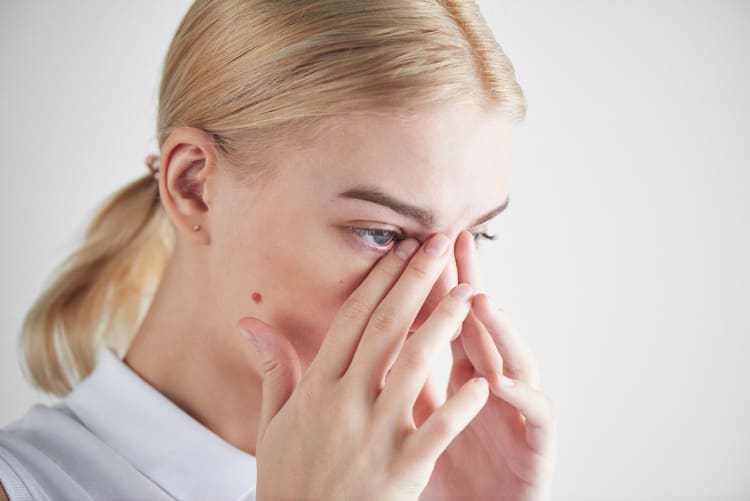Excessive Alcohol Use & Your Body
You may be aware that excessive alcohol use damages your body. Did you know it can damage your eyes? Often when a person suffers from alcohol addiction, they have “alcoholic eyes.” The term refers to the harmful effects excessive alcohol consumption has on a person’s eyes and vision.
Drinking alcohol affects the central nervous system. It can affect eye muscles and change how the brain processes images. Long-term or excessive alcohol use increases the risk of eye damage and disease. While some of the effects of alcohol on the eyes are temporary, others are serious and can be permanent.
Below are 11 ways excessive alcohol consumption can damage the eyes.
- Optic Nerve Damage & Blindness
Optic nerve damage and the neurological damage heavy drinking causes to the brain are closely related. Like the brain, the optic nerve consists of neurological transmitters. Just like the brain, it can become damaged by drinking alcohol. The optic nerve sends impulses to the brain from the retina. If the optic nerve becomes damaged, it can result in low vision or blindness. A damaged optic nerve can cause eye pain, loss of color perception, eye floaters, and vision loss in one or both eyes. Optic neuropathy is the term used to describe any damage to the optic nerve. - Bloodshot or Red Eyes
When a person drinks a lot of alcohol, they often have red or bloodshot eyes. It occurs because the blood vessels in the eyes expand and fill with blood, causing them to appear bloodshot or red. - Dry Eyes
Alcohol is a diuretic. It increases the amount of salt and water that passes through the body. Besides causing a person to urinate frequently, alcohol causes the body and eyes to dehydrate. Eyes can become dry and often painful. - Blurred Vision
When the communication between the brain and eyes becomes altered by alcohol, a person often experiences blurred vision. Blurry vision occurs because the eye muscles cannot work together. - Frequent Migraines with Visual Aura
Alcohol often triggers migraine headaches. Some people experience a visual aura before or during a headache. The visual aura is temporary but can be debilitating. The aura appears as graying of vision, blind spots, or zig-zag, jagged patterns of bright, shimmering lines of light that can spread across the visual field. - Poor Vision from Vitamin Deficiency
Excessive drinking can also cause eye damage from vitamin deficiency. Heavy drinking affects how the liver absorbs vitamins the eyes need for good health. A Vitamin A deficiency can result in dry eyes, night blindness, retinal damage, and corneal perforation. A Vitamin B-1 deficiency can result in weakened or paralyzed eye muscles. - Yellow Sclera
The white part of the eye is the sclera. When a person drinks heavily, the sclera turns yellow. This is a sign of liver damage or disease. - Cataracts
When a cloudy area develops on the lens, it is called a cataract. This condition leads to a decrease in the field of vision. Cataracts usually occur in people over the age of 55, but excessive drinking can cause them to develop earlier. They can develop in one or both eyes. Blurred vision, increased sensitivity to light, difficulty seeing at night, and lack of intensity when seeing color are common signs of a cataract. - Delayed Pupil Reaction
Heavy drinking and binge drinking can cause the movement of the pupils (dilation and constriction) to slow down. When the pupils have a delayed reaction time, they cannot respond quickly to changes in light. One of the reasons driving under the influence is dangerous is because drivers cannot adapt rapidly to oncoming headlights. - Eyelid Twitching
Heavy alcohol consumption can cause a person’s eyelids to twitch. This condition is called myokymia. Myokymia occurs due to the excessive amount of alcohol that slows the pupil’s reaction time. The person feels like their eyes are twitching. - Loss of Vision from Age-related Macular Degeneration (ARMD)
Permanent blindness can occur from drinking excessive amounts of alcohol over a long period. According to the National Library of Medicine, age-related macular degeneration associated with alcohol use can lead to blindness. In the early stage of macular degeneration, shapes are fuzzy and colors are less vibrant. As the retina continues to deteriorate, the individual has difficulty recognizing people’s faces. Over time, the person is unable to focus on their central field of vision.
Do You Need Help?
Addiction is a chronic brain disease that can affect anyone. If you or a loved one is struggling with an addiction to alcohol or drugs, you are not alone. Help is available. Call and speak to a caring professional at Anabranch Recovery Center, located in Terre Haute, Indiana. Now is the time to take the first step.
Considering an alcohol addiction treatment center in Indiana? For more information about Anabranch Recovery Center, and the services we offer, please call and speak with someone today at (888) 302-8095.
- What You Need to Know About Alcohol Addiction
- Symptoms & Timeline of Alcohol Withdrawal
- Understanding the Detox Process: Alcohol Recovery
About the Author: 
Terry Hurley is a retired educational professional and freelance writer with more than fifty years of experience. A former reading specialist and learning center director, Terry loved her years working with children in the educational field. She has written extensively for print and online publications specializing in education and health issues. For the last six years, her writing focus has been on addiction and mental health issues.





